|
The Maker Movement is educations newest and biggest buzzword. Schools around the world are looking to create state of the art maker spaces, but is the Maker Movement just a passing educational fad or is it a revolution in the way we approach learning? 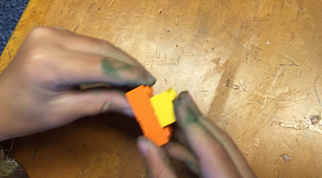 Think of the last time you learned something. A new language? How to use a new computer program? How to play a new card game? Plot that learning in your mind. You may want to plot it in a line. You had a little knowledge to start with then you gained more knowledge. That knowledge connected like a Lego brick to your previous knowledge. Your knowledge built upon itself like a Lego tower, each piece making your knowledge grow higher and higher. Early psychologists supported this view of learning. The brain was described as a blank slate. Memories are etched into the blank slate as they are gained and then new information connects to that and so on. For a long time this is how schools were set up. They were institutions which would pass information on from the owner of knowledge to the recipient block by block. However, this is not a very accurate view of learning. Current studies in neuroscience demonstrate that babies brains are not in fact blanks slates and that memory is not shelved in one section of the brain ready to be pulled out later.1 Rather it is encoded through various parts of the brain.2 The act of remembering is an act of pulling various pieces of information and putting them together. Physiologist Jean Piaget describes how our brains process information through assimilation and accommodation. During assimilation we take pieces of information and put them into our brain without changing the structure of the internal world. This would be like a child building Lego towers. All of the information they are given fits nicely into their blocks of information. Accommodation is when we take pieces of information that don’t fit neatly with the categories in our brain and we make adjustments by developing new categories to accommodate the new information. Instead of picturing Lego bricks building up and up like a singular tower it is helpful to think of how a child plays with Lego bricks. They gain a block and connect it but they don’t just build a tower. They pull those bricks apart and move them around and build a space ship, then they get more bricks and they combine those bricks with some of their space ship bricks to build a castle. So yes, we do get new pieces of information as we learn but our minds do much more with that information than just build towers. We make connections between our learning. We create with our learning. 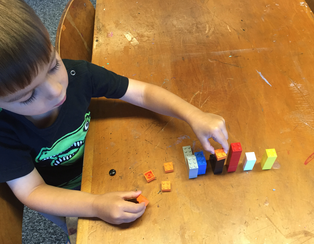 In a traditional school setting all kids are allowed to do is build Lego towers. A progressive education lets kids use those Legos to make something meaningful and then encourages kids to tear that apart and make something altogether new. The Lego tower view of learning is neat and tidy. We can plan for it, build standards around it, report on it and analyze it. That is what we do in education. If we find a problem in education we try to focus on different Lego towers such as focusing more on science and math. Sometimes we try to break the Lego towers down into smaller Lego towers by creating more specific rubrics or by rewriting our curriculum. We try holding teachers more accountable to how tall students Lego towers are getting and how much growth they are having in their Lego towers. We try all sorts of ways to solve our educational problems but in the end none of them work because they are all based on a model of learning that is not realistic. However, it is possible to build schools around block creations instead of block towers. The Maker movement at its core is this type of education. Seymour Papert who is considered one of the fathers of the Maker movement explained this through the term constructionism. “The word constructionism is a mnemonic for two aspects of the theory of science education underlying this project. From constructivist theories of psychology we take a view of learning as a reconstruction rather than as a transmission of knowledge. Then we extend the idea of manipulative materials to the idea that learning is most effective when part of an activity the learner experiences as constructing a meaningful product.” -Papert Constructionism: A New Opportunity for Elementary Science Education Giving students an opportunity to make is more than a chance for students to play it is an opportunity for students to learn effectively across the curriculum. Papert goes on to explain that part of the problem with subjects like Math in school is that students don’t get to use it the way adults do. They don’t use math to make bridges and form theories or make money in the stock market like adults do. “They sit in class and write numbers on a piece of paper.” Papert explains. While teaching students foundational math skills is certainly necessary it is also necessary to give them opportunities to use those math skills. Their is evidence that children of very young ages are capable of solving problems in complex ways like adults do. Child development psychologist Allison Gopnik argues that, like mathematicians and scientists, children are capable of putting forth theories, experimenting, observing, and discerning statistical patterns. “Give a one-year old a set of blocks and you can see her trying different combinations, placements, and angles, and gauging which of these will produce stable towers and which will end in equally satisfying crashes. We have shown that by the time children are four they will intervene in the world in a way that lets them uncover casual structure."1 If we adopt a Maker mentality to education we do more than just teach students important content and skills we give them an opportunity to use those skills and content. Gary Stager, author of Invent to Learn and founder of Constructing Modern Knowledge explains in an interview with American School Board Journal “Making across the curriculum means students as novelists, mathematicians, historians, composers, artists,engineers—rather than being the recipient of instruction.” One of the arguments against this type of education is that it wouldn’t properly prepare students for college entrance exams which are basically block towers. A way around that would be for universities to look at students block creations instead of just their block towers. This is already happening. Just as more and more companies are hiring based on a prospective employees project history. There are a growing number of universities that are looking for what the students can do beyond a test score. My husband, a high school teacher, tells the story of a student of his who got accepted to Yonsei, a top university in Korea based on the video’s on his Youtube channel. Top colleges such as MIT have recently announced that they accept Maker portfolio’s as part of their application process. Makered.org which has a national open portfolio project explained the benefits of portfolios. “Rather than showing the learner knows what has been taught, the portfolio demonstrates that the student can do what has been taught.” In essence a portfolio shows what students can do with their Lego bricks not just what Lego’s they have acquired. Isn’t that what real learning is? True understanding is not just gaining knowledge, it is being able to use that knowledge. Harvard Project Zero explained “If a student "understands" a topic, she can not only reproduce knowledge, but also use it in unscripted ways." While the Maker movement is an example of block creation learning, many schools miss the meaning behind the movement altogether. They are quick to buy expensive equipment and build impressive maker spaces but they try to fit that learning into block towers. It is vital that schools invest in the learning theory behind the maker movement before they investing in maker equipment. Gary Stager explains “The best maker space is between your ears.” He goes on to explain, “I want the bulk of making to permeate every corner of a school building and every minute of the school day.” We need to stop forcing kids to build Lego towers. We need to set them free to understand and create. We don’t accomplish that by buying expensive maker space equipment but by changing our mindset. 1. Gopnik, A.G. (2004) Finding Our Inner Scientist, Daedulus. vol133. pp 21-28 2. Gardner, H.G.(2004), What We Do and Don't Know About Learning, Daedulus. vol133, pp 5-12
2 Comments
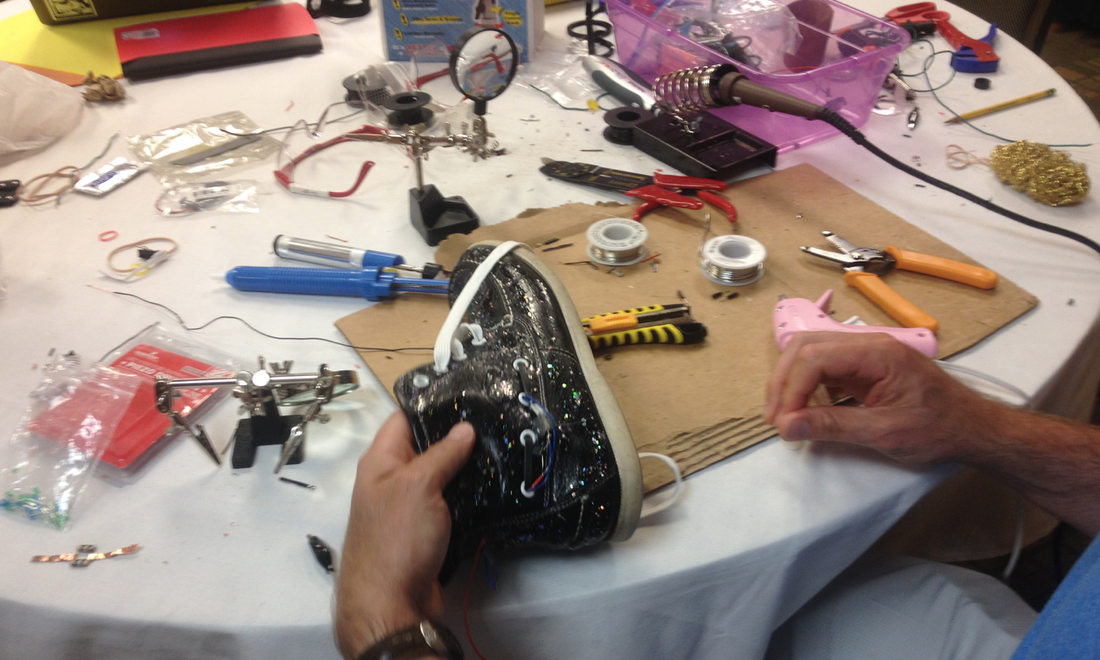 This summer I had an opportunity. The opportunity to attend Constructing Modern Knowledge. The opportunity to interact with many of my educational heros. To experience the joy and hardship of making a challenging project. The opportunity to have thought provoking conversations and to work with an amazing group of educators who inspired me to try things I never realized were possible. All of these experiences were amazing and transformative but the most transformative moment of the workshop for me was not any of these moments. It was when a group of educators with the same opportunity as me walked away from thiers and left the workshop early. It left me dumbfounded. The story I heard was that they had been unhappy with the workshop so they called their administrator who told them to go ahead and fly home. I felt frustrated that they had given up so easily, that they hadn’t chosen to take advantage of such an amazing opportunty. I couldn’t understand how they could make such a choice. David Loader, associate professor at Melborne University had a different reaction. “I know why they left.” Loader said. “They were teachers so they were used to school.” That statement got me thinking. David Loader was right. There was clearly a disconnect between these teachers expectations and what Constructing Modern Knowledge was. Most likely that disconnect stemmed from their experience as teachers. So what was that disconnect? Constructing Modern Knowledge was nothing like any school I have ever been to or any conference I have ever been to. There were no classes, no workshops, no presentations, I didn't sign up to learn about Scratch or Arduino’s or how to create a maker space. Knowledge was not disseminated in the traditional way from the so called expert to the student. Instead we were given a chance to choose a project we wanted to work on for four days. During those four days the experts did not talk at us, instead they walked around and stepped in as we needed. We learned as we worked. We learned about the learning process, we learned about ourselves as learners. We learned about content that was related to our project. For example my group created a shoe that converted energy from walking to useable electricity. So I learned a great deal about circuits and energy. Video courtesy of https://catcomputerteacher.wordpress.com/ All of this was extremely valuable learning but it certainly is not the way that schools usually work. Which is sad because how amazing would schools be if they did have more of that style of learning. Students would be engaged, learning would be relevant, understanding would be meaningful.
But all of this is very hard to do as teachers because of the big T word. Time. We don’t have time to let our kids create because we have to make sure to cover the standards. We need to cover the content that will be tested and reported on. The content that parents and colleges will ask about. This led me to the realization that what is wrong with schools is not the teachers or parents, administrators or even funding. What is wrong with schools is the way we think about learning. We frame our educational system around an outdated view of learning. I call it the block tower view of learning. I’ll explain it in my next blog post. 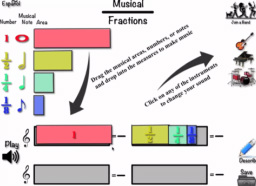 I believe that any conversation about teaching coding is incomplete without a look at how it can be used to enhance the curriculum. Coding applications such as Scratch and Gamemaker are open ended and give a teacher more flexibility to differentiate then a worksheet or pre-made app. It also gives students the ability to create. This ability makes student's learning meaningful and gives them more ownership of their learning. In such a situation learning to code is secondary to the lesson objective. Don't get me wrong, teaching coding explicitly is important but as a 5th grade teacher what really gets me excited is seeing how coding has enhanced my curriculum. One example of this type of lesson is when I taught fractions using music. Lesson Objective: "Describe, continue and create patterns with fractions, decimals and whole numbers resulting from addition and subtraction" - Australian National Curriculum Year 5 My Thoughts: I was having a coffee and discussion with a Alexis Ramsey, a music teacher at my school when I was struck by something she said. She explained that music is great for teaching fractions. At the time I was teaching fractions and loved the idea of pulling in music to teach the above curriculum standard. My immediate thought was that if I could get my students to hear fractions, it might make better sense to them. In looking for resources to teach this lesson I came across the iPad app (pictured left) which had promise but was limiting. It wasn't open ended. I wanted opportunities for differentiation and creativity. As cool as the app was, it was still someone else's creation and therefore limited to the imagination of that person. I wanted the end result of the lesson to be limited by nothing more than my students. Therefore I came up with the idea of using Scratch to teach the lesson instead. With Scratch students would be able to create their own app. They would be able to write and listen to their own music. In the end my students were all able to meet the lesson objective of continuing a pattern using addition and subtraction of decimals and fractions. They were all able to identify the pattern they created and describe how they applied their understanding to coding. I could have taught my students this same concept in many different ways but I can't imagine them being any more engaged or excited about their learning as they were with this lesson. Anyone who thinks coding sounds boring has never seen a group of 5th graders coding their own music. Lesson Outline:
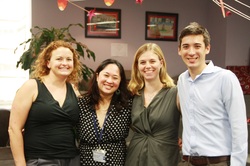 Part 2-The Global Codeathon We had chosen the date of May 17. We only had 2 months to get this off the ground. The first thing Michelle and I did was to form our team. My husband and COETAIL graduate, Dan Slaughter volunteered to be a part of the team. We then recruited Heidi Kay who helped start our schools Coding Club. First task: Define the idea. We decided that the main purpose of the event is for elementary students to connect, create and compete with other elementary kids around the world. With this in mind we decided to call the event the Global Codeathon. Second task: Find interested schools We started with a simple flyer which explained our idea. We then made a website, sent word out via Twitter, Google+, and at our presentations at EARCOS and ASB unplugged. We began to get some initial interest from schools but not commitments. Timing was tight and coordinators needed to get their schools approval and see if their students were interested. Third Task: Get students interested and schools committed. To gain some momentum we asked our coding club students to help us create a promo video. We also started putting together useful documents for schools such as flyers and posters that they could print and letters they could send to parents. Then we began my favorite but most time consuming aspect of the Global Codeathon. We began contacting the interested schools and discussing questions and ideas with them. This communication started out mostly through e-mail and then eventually moved to Skype Callls and Google Hangouts. It was exhilrating to speak with teachers and tech coordinators around the world who had similar interest in integrating coding into schools. This was the point where our team felt the pressure.This was when our idea would either stay as nothing more than an idea or it would materialize to a global event. As schools started to commit this idea started to become a reality. One by one schools took a leap of faith and committed. I felt such a kinship to the participating schools around the world. We all believed in a common idea and were willing to take a risk on it. None of us knew for sure what the event would look like. All of us had to put ourselves out there to Heads of Schools, to parents and to students by participating in the first event of this kind. All of these schools around the world took a huge risk and in doing so they made an idea come to life. Fourth Task: Plan the logistics. Connect: One of our biggest questions was how would we actually connect. After gathering feedback from participating schools the plan for the day began to take shape. Many of the participating schools had beginner coders and were interested in having us lead sessions. Schools were also keen to be connected to other schools worldwide rather than just UNIS. We decided that in order to do that we would use Google Hangouts. This way schools could hear us leading a virtual session but also see other participating schools around the world. In order to aid in the global collaboration and to help answer questions we set up a backchannel and we recruited several experts to man our backchannels. That way students could ask questions virtually and have their question answered. We also had lesson materials and helpful tips available on our website in case connectivity was a problem. We decided to start with one big Google Hangout where students around the world could say hello to each other. Create: Next we would split into intermediate and beginner sessions which schools could tune into or run themselves. Finally we would finish by letting students play each others games on Scratch via Scratch Galleries and by having a select student from each school share their program in a closing Google Hangout. 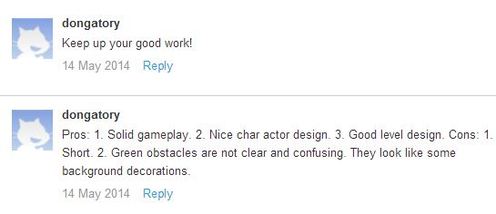 Compete: Competing was a bit tricky. We knew competing would be a great motivation for some students and could inspire students to code year long much the same way that an athlete spends time preparing for a tournament. However, we also were weary that competition could ruin the event for some students. So we decided to make the competition aspect optional. In order to give students time to make something more interesting we felt they needed longer than the 2 and a half hours they would get on the day of the Codeathon. We released the theme of "Superheros" to all students 2 weeks prior to the submission deadline. One of our highlights of this entire event was that Dong Nguyen (the creator of Flappy Bird) agreed to judge the Advanced Competition. He even donated Flappy Bird T-shirts which we used as prizes. It was amazing to see Dong Nguyen comment on students games and give them useful feedback.  5th Task: Plan and pray that it will actually work The first time you try something is always more scary because no matter how well you plan for it you can't anticipate what may actually happen on the day. One thing we hadn't expected was that we would crash our own website by directing everyone to access lesson materials on it. Thankfully the problem was fixed in a relatively timely manner and we all did what teachers do best. We adjusted and made it work. The day of the Codeathon was amazing to me. Watching the students wave at each other from all around the world was one small moment which encapsulated what we had been working toward. It had actually happened. Students from all over the world really were connecting. Their connections were meaningful. Weeks later students continue to comment on each others programs and give each other feedback. Students were proud of what they accomplished and inspired to try new ideas. Final Task: Reflect
Reflection gives you the chance not only to learn from your experiences but also a chance to grow from them. So of course we held meetings, spoke with students and sent out a survey to participating schools. With the information gained we have started to look at how to go forward with this event in the future. The Global Codeathon will be held again next year on May 16 and hopefully for years after. Because if there is one thing we learned from all of this it is that it we have only just begun. 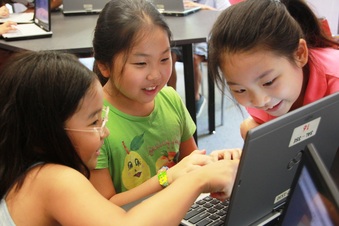 The kids had all gone home, Google Hangouts had been turned off and laptops set in charging carts. My fellow coordinators stood beaming and then we did something we hadn't done in weeks. We stopped and took a breath. It had worked. Through the collaboration of 15 schools we had pulled off what only weeks ago had felt like the most ridiculous idea we had ever had. 200 kids from 15 schools around the world had come together for the first ever Global Codeathon. We took a breath and thought back for a moment at how we had gotten to this point. For myself the story of the codeathon goes back to when I was first introduced to teaching coding in schools. As chronicled in my earlier post I was inspired to learn coding with a small group of students after watching the video "What most schools don't teach." The result of my first experiment with teaching coding was enough to convince me of it's benefits. I found that by teaching coding, my students were improving many skills such as art, design process and math. In my previous post I reflected; "I remember one day when I was teaching coordinates, one of my coders raised his hand and explained to the class what the X and Y axis were. I asked how he knew that and he told me he had learned it while working in Scratch." What probably excited me the most about teaching coding wasn't the increase in student math scores it was the endless possibilities it opened for students. I found that student's creativity and problem solving increased. "The reason I have come to love teaching coding is not because I enjoy coding, it is because I love the possibilities it gives my students. It takes the box of a pre-made app or program away and lets students be the creators." The more time I spent teaching students coding the more excited I got about it. This was not just something to teach kids because we hope they'll grow up to become rich programmers, it is something to teach kids because we want to open up possibilities to them. But still the question lingered; How do we get this into schools? One approach is to integrate coding into the curriculum. Another approach is to teach coding outside of the classroom. I have found that both approaches are valuable and necessary in their own way. Integrated: As I integrated coding into lessons, students learned to code through content such as math and science. This not only increased their coding skills but was also a powerful way to teach specific math and science concepts. Students then went on to demonstrate their understanding of other concepts through coding as was demonstrated in the PYP Exhibition. Outside the Classroom: Three teachers and myself founded the Coding Club as an after school activity where students met once a week to learn and improve their coding skills. It had become a popular after school activity. Like many schools around the world we participated in the Hour of Code. Our Coding Club students ran the Hour of Code for elementary students and teachers who wanted to be introduced to coding. The event was very successful. Students and teachers went away from the hour excited about what they had learned and eager to learn more. It was a great start but I knew we could do more. All around the world schools had participated in the Hour of Code. How could we learn from each other? How could we build on this momentum? Going beyond the Hour of Code: It started as a conversation. Justin Hardman from 21st Century Learning and I met at the Vietnam Tech Conference and started discussing our mutual interest of integrating coding into schools. He talked about how great it is that athletes get to meet each other at tournaments and he wondered if we could give coders a similar experience. His idea was for kids to meet up with kids from other schools and code together in a hackathon style event. I loved the idea but because I work with Elementary kids I knew traveling internationally to something like this wasn't an option. So I began to dream about the idea of having a codeathon virtually. There were thousands of schools around the world who had participated in the Hour of Code or were teaching their kids to code. Some schools had after school coding clubs like ours, others had done a one time event and would be looking for a next step. It made sense to get those kids together to learn from each other and inspire each other. A codeathon would be the type of exciting event that could inspire kids to code on their own. If this went well then students would have something to look forward to every year. This could also help get coding into classrooms. With a group of students capable of coding at various schools my hope was that teachers would then feel more confident to give coding a try.They would see the benefit of coding first hand and would have a group of coding helpers ready to assist other learners. I was excited by the possibilities so I brought my thoughts to Michelle Matias (UNIS's Elementary Tech Coordinator) and the idea of a virtual Global Codeathon was born. The Codeathon Part 2-"Taking an Idea Global" to be posted soon 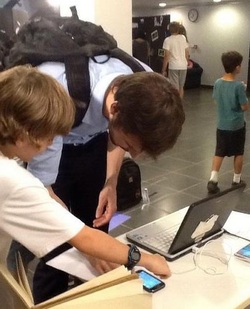 One thing that has always been important to me is student choice. My experience has been that choice empowers students and that empowerment gives them the intrinsic motivation that us teachers love. I found early on in my teaching that when I gave students choice they actually worked harder, learned more and owned their learning to a higher degree. Today in education student empowerment has continued to play an important role. Project based learning, product oriented learning, design thinking and the maker movement all emphasize student choice within the learning and creation process. The PYP places heavy emphasis on students having ownership of their learning. The IBO website states, "Students who learn in this way begin to reflect on their roles and responsibilities as learners and become actively involved with their education." The key in that statement is "actively." The PYP wants students to be active in their education, part of being active in your education is actively choosing how you demonstrate your understanding. The PYP Exhibition is the "culminating experience" of the PYP. It is no surprise then that with the PYP Exhibition, schools give students considerable choice both in what students inquire into and how they display their understanding. After our students have inquired extensively into a topic we let each group choose how they will present their understanding. This year we had some students write music, create art installations, create websites, make movies, design interactive simulations and many more. It is always inspiring to see the wide variety of ways that students choose to demonstrate their understanding. The depth of understanding that these 5th graders have often amazes me. 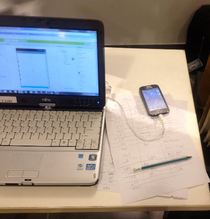 I was both surprised and excited when I realized that several groups chose to use coding to design a program which would demonstrate their understanding. One group was inquiring into benefits and negatives of cell phone use. In order to demonstrate the positive use of cell phones two members of the group created their own apps using MIT App Inventor. What I loved about that is that I hadn't taught these students MIT App Inventor. I had taught them Scratch and introduced them to app inventor but they taught themselves how to use App Inventor with no help from me. 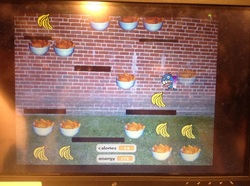 Another group of students was looking into healthy lunch choices and two of the students in the group decided to make a game where the player needed to try and eat the banana's and avoid the unhealthy foods. For every banana that they ate their energy level in the game went up. For every junk food their calories went up. It was an engaging way for the students to demonstrate their understanding. A third group of students used Scratch to create a program which would first teach participants about the effects of climate change, then quiz them on their understanding and then give them an opportunity to play an interactive game. All of these students realized something many adults don't, programming has limitless potential. It is much more then syntax to be memorized. It takes away the box and lets students create in new ways. What is really cool is that many of these students weren't even in our weekly coding club. The student who created the banana game and the student who created the app weren't even in my homeroom class. I had come in and taught one math lesson and one science lesson in their classroom using Scratch. That was all the introduction they needed. The rest they learned on their own. What that means to me is that maybe this won't be as hard as we think. Even if all we do is introduce kids to coding we at least start to give kids the opportunity to learn it on their own. We open up that learning possibility for them. We start to empower them. It is exciting to see where they go from their. "For truly creative people there is no box"-Yong Zhao A few weeks back I attended and presented at the EARCOS Teachers Conference in Bangkok. For me EARCOS was a bit like completing a puzzle. There were lots of independent pieces of information that I took in from conversations and presentations with Hamish Clark, Wendy Smith, Brian Smith and Yong Zhao. With each interaction I began to get a clearer picture of what this all meant to me. My big takeaways were * Kids need opportunities to design * Coding is a creative outlet I once heard a children's author explain, "I have the best job in the world. I get to write and create whatever I imagine. That is much more exciting than just reading what someone else wrote." What I have come to realize is that sentiment is true anytime we create. Letting students create gives them ownership of their thinking. Yong Zhao explained, "If you create a product you have a purpose. Learning should serve a genuine purpose. Students take more responsibility. Students get into the habit of trying to become great. You want children to learn that they can become great through effort." I have seen this in my students when they create something in Scratch or when they create websites with HTML and CSS. I don't have to design lessons for them. They figure out what they need to learn in order to accomplish their task. I end up becoming more of a learning coach and less of the holder of knowledge. Hamish Clark who attended my workshop spoke to me and explained that the crux of what I am doing with my kids is not teaching them to code, it is giving them a vehicle to be creative. I had never thought about that before but he was exactly right. The reason I have come to love teaching coding is not because I enjoy coding, it is because I love the possibilities it gives my students. It takes the box of a pre-made app or program away and lets students be the creators. 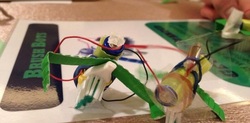 I got to experience what it is like to be a creator when I attended Brian and Wendy Smith's "Young Makers" workshop. They had tables set up throughout the room and on each table was a challenge. I got to make a robot toothbrush. During that experience I learned that creating while highly engaging is also challenging and it is in that challenging moment that true learning happens. While I was challenged I had to rethink my design, I had to problem solve on how I could get the pieces to stick. When I figured out the answer and successfully made my Brush Bot I experienced the satisfaction that students feel from accomplishing a task. From this I was inspired to take some key next steps in my classroom: 1. Give students regular opportunities to be creative by setting up making times where they get to explore both with coding and physical materials. 2. Make summative assessment tasks open enough that students can chose to code something to demonstrate their understanding. Previously I had introduced my class to Makey Makey's, through an Electricity unit. It was a great way to get kids coding and to explore Makey Makey's, but what was missing was an opportunity for students to design. An hour of maker time was the perfect next step for my students. For my first attempt at giving kids creative time I set out 4 Makey Makey's, some electrical equipment, clay, string, and magnets. Then I gave students the next hour to see what they could create. It was awesome. Most of the kids chose to work with others. Some students wrote animations on Scratch, others created games that they controlled with magnets or clay via the Makey Makey. Every single student was engaged for the entire hour, every student reflected that they felt successful because they figured out an answer and overcame a problem. It was great to see students all over the room throwing up their hands in excitement as they figured out how to do something. A week later we had Heidi Kay's fourth grade class come walk around and see what we created. This gave my kids an audience to share their creation with and it gave the 4th graders some inspiration for what they could do. Having coworkers such as Heidi who are eager to try out new uses of technology is great because we can try out new ideas together and give each other feedback. It feels like a small step but it is a step. It is not a maker space or a DIY night. But it is a step to my classroom and the school becoming the type of place Yong Zhao described. A place where students design, create and own their learning. A step to teaching beyond the box. Students discussing their design ideas.
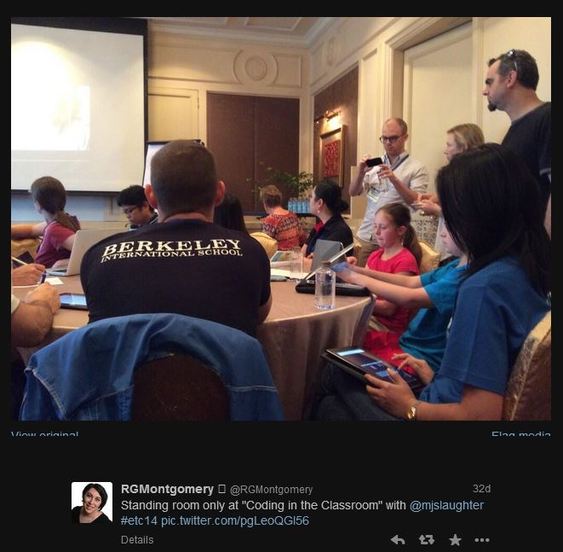 I am a person that tends to have a hard time saying no. I am a sucker. I am the sucker that you look for when you need a volunteer to coach, or lead Sunday school or to cover your recess duty. I just can't say no very well. Speaking in public however is one task I have never had a problem saying no to. I never wanted to do it, and no matter how many times someone wonderful like Michelle Matias encouraged me to speak about my experience with coding I could easily laugh at her and say, "No, not going to happen." I am no expert on coding and I had no desire to stand in front of an audience and pretend to be one. But then she did it. She convinced me when she said, "Mindy just think of all of the teachers out there like yourself who are interested in teaching code and are just starting. Just tell them your story." That got me thinking, there probably are a lot of teachers out there like myself who are a bit freaked out when they first heard about teaching coding but are willing to give it a try. Teachers who aren't sure what that might look like and they just might get something out of hearing my story. They may even be encouraged that someone as non techie as myself could introduce kids to coding. So I signed up to speak, first at Vietnam Tech Conference and then at EARCOS. I spent hours researching and connecting with other like minded people. I connected with amazing people like Chez Vivian and Joe Schmidt who took the time to give me feedback and new ideas. I learned a great deal from preparing my presentations. My presentation felt ready. The entire presentation was aimed at teachers who are new to coding. I was going to tell my story to other teachers and hope to encourage them in their journey. Then I stood at the front of a room full of participants and realized I had it completely wrong. I had a room full of tech people. There were a few classroom teachers in the audience but the majority were tech facilitators. I went ahead and told my story anyway and what happened surprised me. They asked questions. Questions like, "How do you see this fitting into the curriculum?" and "What resources would you recommend for teaching coding to an 8 year old?" I realized that these impressively techie people might be more capable coders than most teachers but they have the same question that teachers do, "How do we actually make this work in our school?" Speaking with the participants was awesome. I came away having learned more than I taught. I gained new insight and new inspiration and along the way somehow I helped encourage others. Riki who attended my workshop at Vietnam Tech Conference might not know it but when she posted the below tweet it did more than make my day. It felt like my preparation had been worth it. I spoke with Riki via Skype the other week. She mentioned that although she had been nervous she started her schools coding club that week. She said it was a big leap for her. She said their was so much excitement that they had maxed out the number of students who could attend. Hearing that and knowing I was a small part of encouraging her to take that step made me really glad that Michelle convinced me to present. Sometimes saying no is overrated. Say yes, take a leap. Coding is science. Chez Vivian made this important discovery and explained to me that the steps to coding are the same as the scientific method. You put forth a hypothesis, you test your hypothesis, formulate your discoveries and then come up with a new understanding. You try to create something in code. You test out your idea, it either works or doesn't and then you have a new understanding and can try a new hypothesis. So what better way to incorporate coding into the classroom then in science. My students were studying electricity. They had already had a couple of lessons where they played around with various materials circuit materials. They had made several important discoveries and developed questions related to which materials would make a circuit work. Which was perfect because one of our lines of inquiry was:
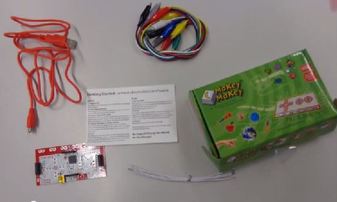 I had the perfect tool to help students test this hypothesis, a MaKey MaKey. I bought a Makey Make over the summer because they looked awesome. I loved the potential they had for creativity. Basically it works by plugging it into the computer and then attaching the crocodile clip to a conductor. That conductor then acts as the controls for a computer. So for example if you clipped the Makey Makey to a paper clip, every time you touched the paper clip you could have it act as the space bar. 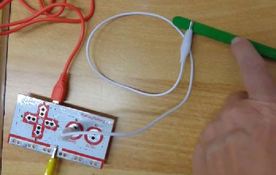 The MaKey Makey was perfect for my science lesson because it basically is a circuit which controls the computer. If it is hooked to a conductor it will control the computer. If it is hooked up to an insulator it won't work. My students had predicted what would conduct and what wouldn't. They then gathered various materials around the room to test. For example one group of students chose paper clips, pencils, a stuffed animal, an eraser, water, and a whiteboard marker. 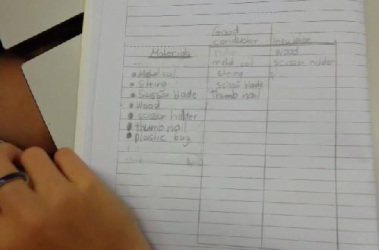 They then hooked up the Makey Makey, wrote a very basic program in Scratch and tested to see which objects made their program work. In this example the group wrote a program where if you press the space key, the cat turns 15 degrees. But what really happened is the character turned when the student touched a paper clip but he stood still when the student touched a pencil. As the students tested various materials they kept track of their findings. They were super engaged and in the end they had a great understanding of what a conductor and insulator were. 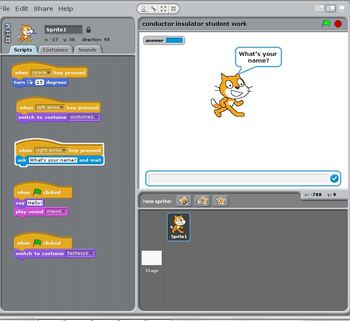 They also had the chance to make some basic programs in Scratch. I did this as a whole grade 5 rotation so for many students, this was their first time using Scratch. I loved that the kids got to dabble in what could be possible with Makey Makey and coding. I really hope to give them more time to design and create something really cool with it such as a Powerpad style pong game or a piano like the one from the movie "Big". Their are all sorts of possibilities. And as the kids work on creating some of those possibilities the scientific method will be how they figure it out. 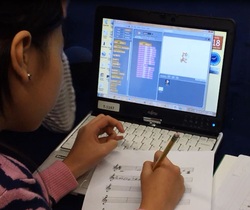 Two of the biggest questions that need to be asked about coding are when and who. When do we teach it? Who is responsible? Anytime we learn something new we must be taught explicitly how to do that said thing. We must also be given time to apply that skill. I believe this also applies to coding. We need time for kids to learn it as a stand alone subject. This can be done in after school coding clubs, lunch clubs, specialist classes or in the classroom. At my school three teachers (including myself) and the Elementary Tech Coordinator started our own Elementary Coding club and I know of other schools who have done similarly. It has been a fantastic place to introduce kids to coding concepts and let them begin to create with their knowledge. However, I believe that we can't stop there. Coding must be integrated into the curriculum. To teach it only outside of the classroom is similar to teaching someone how to write an essay but never giving them an opportunity to write an essay about something they are learning in school. Knowledge must be relevant to students in order for it to be retained. Our job as classroom teachers then is to figure out how it can be integrated into our classrooms. We need to stop thinking of coding as something that just the "tech" people teach. It is something we can teach. It is something we can use as a powerful tool to enhance student learning. The more I learn about coding the more opportunities I find for incorporating it into my class. Here is a link to a document which lists various ways that coding can be brought into a classroom. Anyone can edit the document so please add any lessons or ideas that you can think of. Thanks to everyone who has contributed so far. I hope that as we all begin to learn from each other, coding can become something that is not just an extra subject to teach, it can become embedded into our teaching practice. |
AuthorMindy Slaughter is a classroom teacher at UNIS Hanoi. She started learning to code when some of her students wanted to study it for the PYP Exhibition. She has since help start the Elementary Coding Club and is a founding member of the Global Codeathon. She believes coding opens the doors for student creativity and is working to integrate it into the curriculum. Archives
July 2015
|
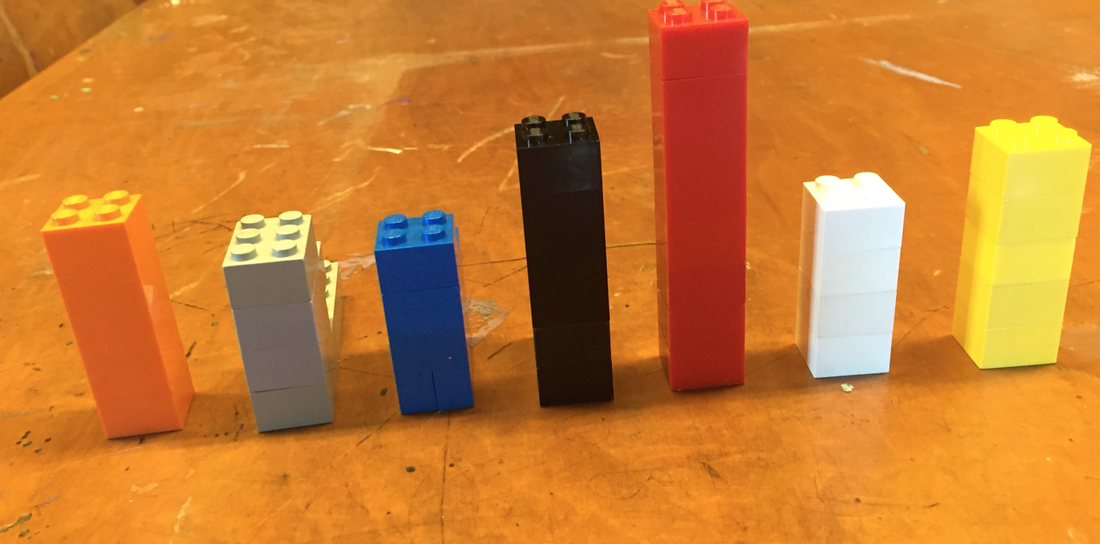
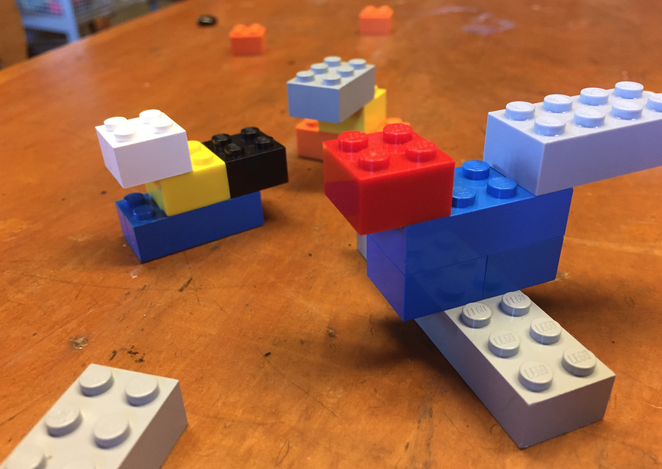
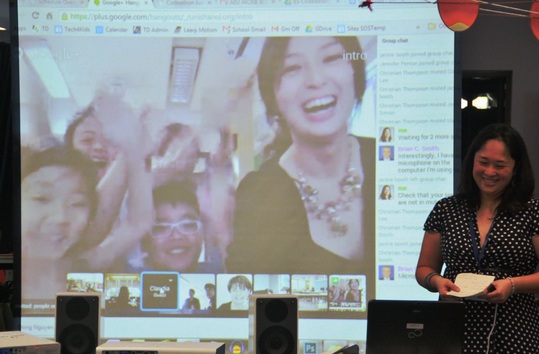

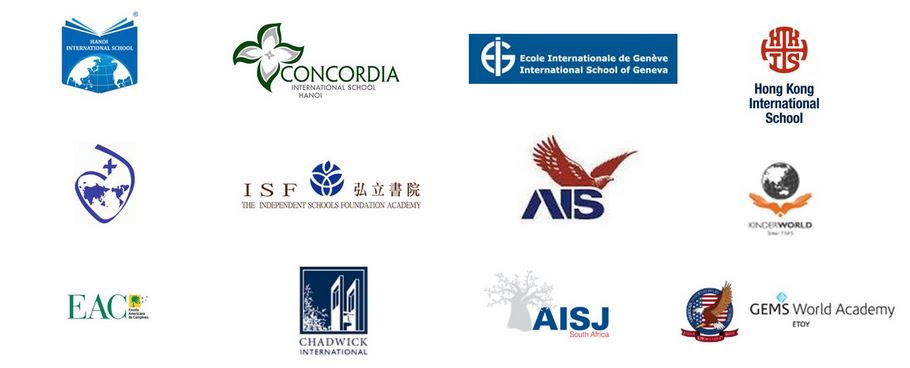
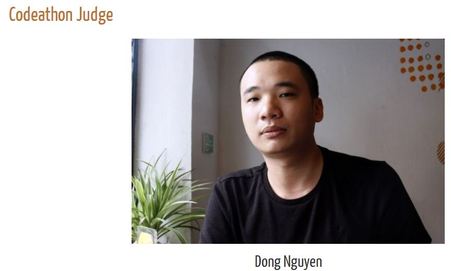
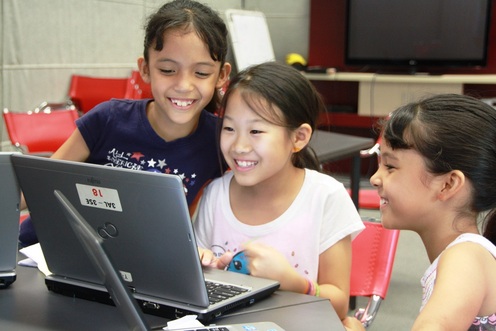

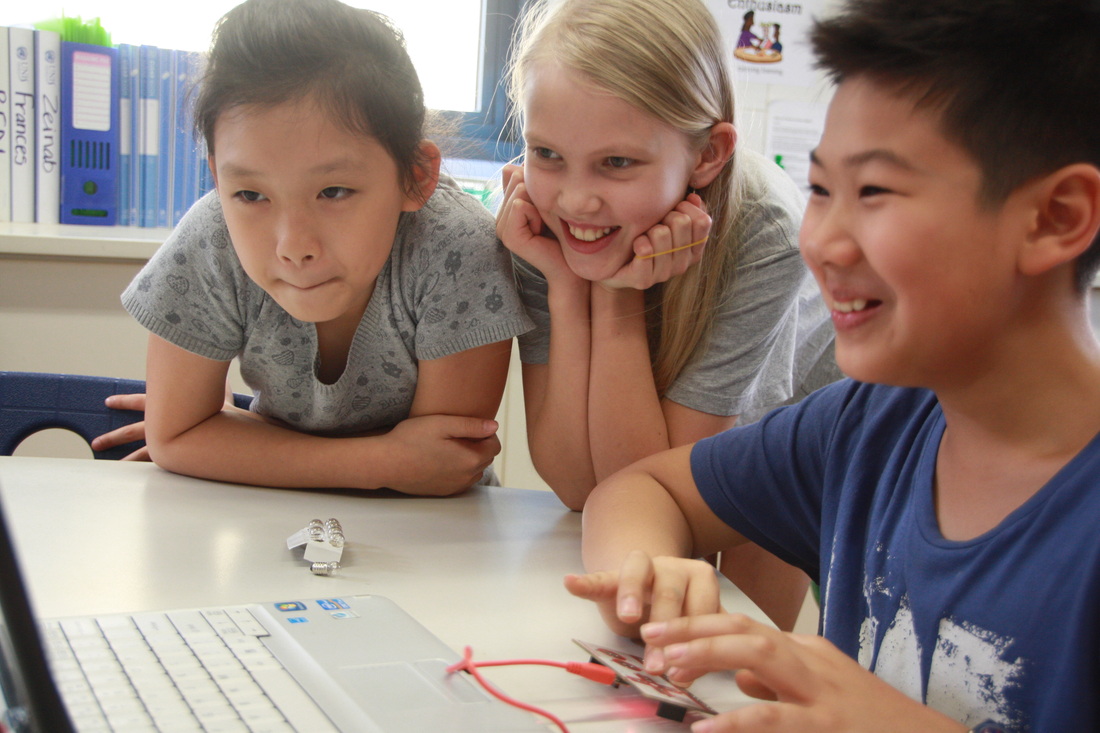
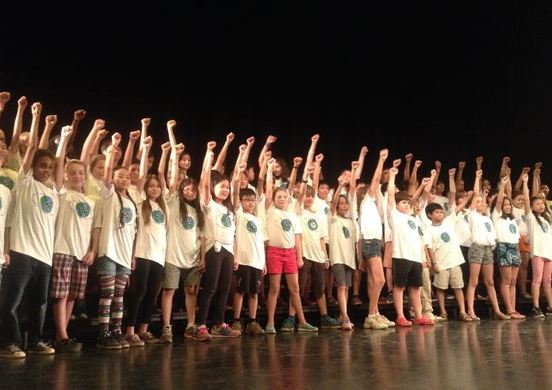
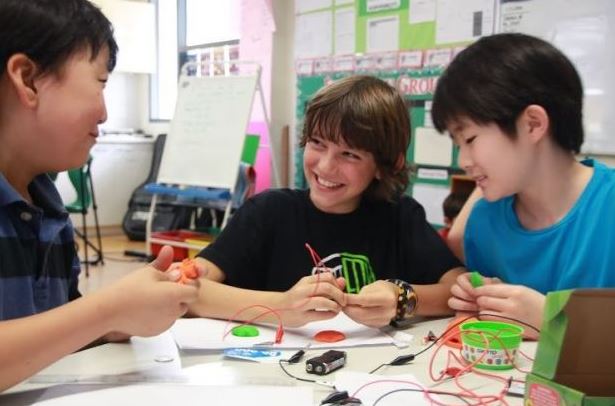
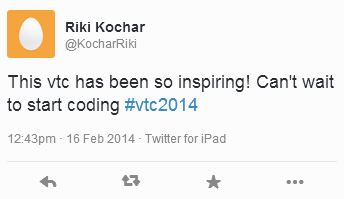
 RSS Feed
RSS Feed